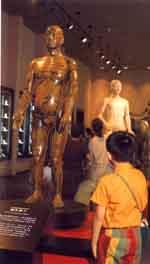Acupuncture
 Acupuncture treatment involves the insertion of needles into the body at one of the many well-defined insertion points. It is based on the philosophy of the Yinand Yang, or the female and male principle. The Yin is associated with the Earth, the Yang with the Heavens. Both forces act throughout the universe and consequently also in the human body. Proper balance of the Yin and Yang in the body produces health and keeps the ch'i, or vital life force, flowing.
Acupuncture treatment involves the insertion of needles into the body at one of the many well-defined insertion points. It is based on the philosophy of the Yinand Yang, or the female and male principle. The Yin is associated with the Earth, the Yang with the Heavens. Both forces act throughout the universe and consequently also in the human body. Proper balance of the Yin and Yang in the body produces health and keeps the ch'i, or vital life force, flowing.
The ch'i is thought to flow along twelve pathways ("meridians"), which are associated with the major organs such as liver, kidney, heart and others. The practice of acupuncture aims at a redistribution of Yin and Yang with the aim of letting the ch'i flow freely through the meridians.
The photo shows acupuncture models on display in the National Museum of Natural Science in Taichung, Taiwan. The bronze figure in the foreground is a copy of the original cast made by Wang Weiji during the Sung Dynasty. 666 acupuncture points are indicated by holes and their names inscribed next to them. During examinations the figure and the names of the points were covered with wax and the model filled with water. The student was then asked to insert a needle in a specific point. Water spilled out if the point was located correctly.
home
 Acupuncture treatment involves the insertion of needles into the body at one of the many well-defined insertion points. It is based on the philosophy of the Yinand Yang, or the female and male principle. The Yin is associated with the Earth, the Yang with the Heavens. Both forces act throughout the universe and consequently also in the human body. Proper balance of the Yin and Yang in the body produces health and keeps the ch'i, or vital life force, flowing.
Acupuncture treatment involves the insertion of needles into the body at one of the many well-defined insertion points. It is based on the philosophy of the Yinand Yang, or the female and male principle. The Yin is associated with the Earth, the Yang with the Heavens. Both forces act throughout the universe and consequently also in the human body. Proper balance of the Yin and Yang in the body produces health and keeps the ch'i, or vital life force, flowing.